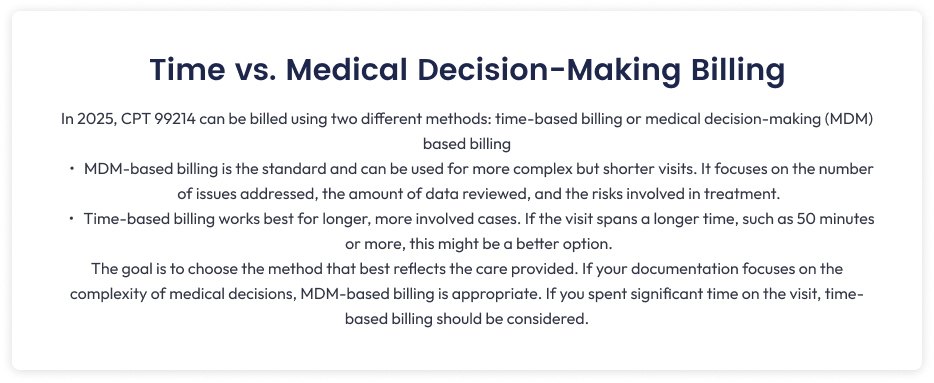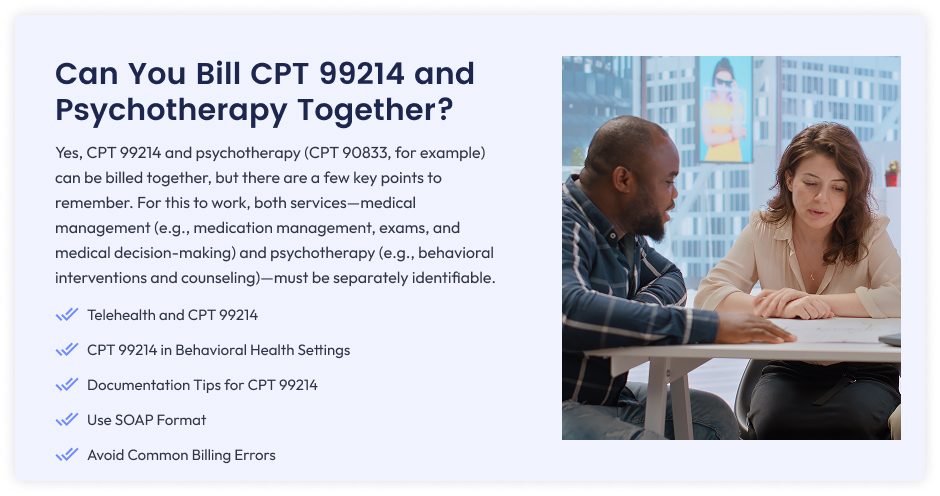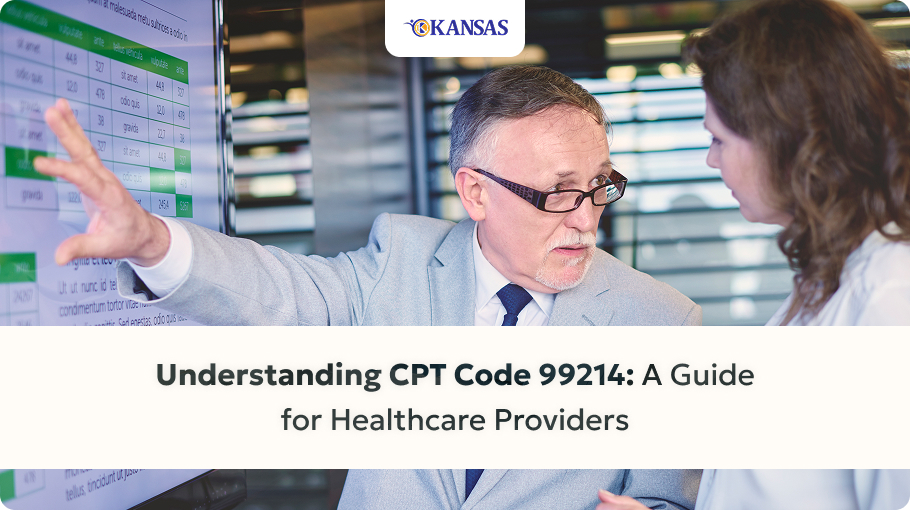CPT Code 99214 is one of the most frequently used codes for outpatient office visits, especially when the care provided involves moderate to high complexity.
The American Medical Association (AMA) has updated the Evaluation and Management (E/M) guidelines for 2025, and healthcare providers, coders, and billers need to understand these changes. These updates will affect how CPT 99214 is used, documented, and billed.
This guide will break down the key details about CPT 99214—when to use it, the required documentation to avoid mistakes, and tips to streamline your billing process.
Properly utilizing this code ensures that providers and outpatient facilities get paid fairly and helps maintain compliance with evolving payer policies and increasing audits in 2025.
What is CPT Code 99214?
CPT Code 99214 is used to report E/M services provided to an established patient in an office or outpatient setting. You use this code when the visit involves moderate complexity in medical decision-making or when the total time spent during the encounter meets the requirements outlined in the 2025 AMA guidelines.
Understanding when and how to use CPT 99214 is crucial for providers and coders. Proper documentation and correct use of the code ensure accurate claim submissions, appropriate reimbursement, and compliance with changing standards.
Level 4 Visit: Complexity Breakdown
CPT 99214 is considered a Level 4 office visit. It indicates a thorough history and examination, along with moderate complexity in medical decision-making (usually about 30-39 minutes of provider time).
Outpatient providers use this code in two scenarios
- Medical Decision Making (MDM): Moderate complexity. MDM is the process by which doctors formulate diagnoses, treatment plans, and management strategies based on available information and risk factors.
- Time: Between 30 to 90 minutes spent on the visit, including pre-visit review, in-person time, documentation, and coordination of care.
Typically, follow-up visits for chronic diseases, acute issues requiring in-depth care, or situations involving medication management and referrals will fall under this code.
What Qualifies for CPT 99214?
To justify using CPT 99214, the patient’s condition must require a moderate level of clinical judgment and coordination.
Medical decision-making for this code needs to meet at least two of the following criteria:
- Problems Addressed: This could be a chronic condition that is worsening, progressing, or causing complications. Or it could be a new problem that requires a detailed evaluation.
- Data Reviewed: This involves reviewing medical records, interpreting lab results, or consulting with other providers about the patient’s care.
- Risk of Complications: Moderate risk involves managing prescriptions or performing procedures with no significant risk factors.
For example, a diabetic patient with rising blood sugar or someone with asthma experiencing worsening symptoms could qualify for CPT 99214. These situations demand careful evaluation and complex decision-making to ensure proper management.
Time vs. Medical Decision-Making Billing

In 2025, CPT 99214 can be billed using two different methods: time-based billing or medical decision-making (MDM) based billing.
- MDM-based billing is the standard and can be used for more complex but shorter visits. It focuses on the number of issues addressed, the amount of data reviewed, and the risks involved in treatment.
- Time-based billing works best for longer, more involved cases. If the visit spans a longer time, such as 50 minutes or more, this might be a better option.
The goal is to choose the method that best reflects the care provided. If your documentation focuses on the complexity of medical decisions, MDM-based billing is appropriate. If you spent significant time on the visit, time-based billing should be considered.
Medical Necessity:
The services that fall under this code must be billable and medically necessary as per insurance payer guidelines. Just because a visit is lengthy or involves complex documentation doesn’t automatically justify using this code.
The care must be genuinely needed for the patient’s diagnosis and treatment.
To demonstrate medical necessity, make sure your documentation includes:
- The details of symptoms or worsening conditions that require evaluation.
- The record of clinical reasons for any treatments, tests, or changes in therapy.
How is the care plan appropriate and necessary?
The complexity of the medical decisions or the total time spent during the visit.
Common Clinical Scenarios for CPT 99214
CPT 99214 is ideal for patients with complex or unstable conditions that require detailed management.
Common scenarios that may qualify for this code and are medically necessary include:
Hypertension: Poorly managed blood pressure, even after adjusting medications, requiring in-depth counseling and follow-up.
Type 2 Diabetes: Diabetes with complications like neuropathy or nephropathy, requiring medication adjustments or coordinating care with specialists.
Chronic Pain: Ongoing pain management, reviewing opioid therapy, or counseling patients on alternative treatments.
Mental Health: Managing moderate depression or anxiety, adjusting medications, or coordinating care with a therapist.
Because these are the critical conditions and are solid proof of the medical necessity, hence, the provider will assign the CPT 99214 code, fill the form, and submit the claim to the payer.
CPT 99214 and Reimbursement
Now the key stage comes where the outpatient clinic will get reimbursement while applying this code. Remember, payments vary by payer, region, and service settings, but for reference, Medicare reimburses about $128.16 for this code.
Private insurers like Cigna or United Healthcare typically reimburse higher rates, such as $174.28 or $124.63, respectively.
So always check the fee schedules for your respective payor to get properly and timely reimbursements.
Here is a snapshot of CPT Code 99214 reimbursement rates according to payerprice.
| Code | Medicare Rate | Avg. Cigna National Rate |
| 99214 | $128.16 | $174.28 |
Can You Bill CPT 99214 and Psychotherapy Together?

Yes, CPT 99214 and psychotherapy (CPT 90833, for example) can be billed together, but there are a few key points to remember. For this to work, both services—medical management (e.g., medication management, exams, and medical decision-making) and psychotherapy (e.g., behavioral interventions and counseling)—must be separately identifiable.
If you’re billing both, be sure to:
- Document each service clearly and separately.
- Add modifier -25 to the E/M code (99214) to show that the E/M service is distinct and medically necessary.
Telehealth and CPT 99214
Telehealth has become an essential part of healthcare, and you can also bill CPT 99214 for virtual visits. The same clinical requirements apply—just like in-person visits, the care must be moderate complexity, and all documentation must meet the standard guidelines.
For telehealth, be sure to use the correct Place of Service (POS) codes, depending on where the patient is located during the visit. These are:
- POS 10 for patients at home (usually preferred for Medicare).
- POS 02 for patients in other locations, like clinics or schools.
CPT 99214 in Behavioral Health Settings
In behavioral health, CPT 99214 is used to bill for moderately complex E/M services, especially when managing medication, conducting diagnostic evaluations, or handling multiple mental health conditions. It’s important to distinguish between psychotherapy codes (like 90833) and E/M codes (like 99214) in your documentation.
Documentation Tips for CPT 99214
Your documentation must support the moderate complexity of the visit. For time-based billing, ensure the provider spent at least 30 minutes on the encounter. Alternatively, for MDM-based billing, document the complexity of the medical decisions being made.
Use SOAP Format:
SOAP format is the best way to document scenarios under CPT 99214:
S (Subjective): The patient’s reported symptoms (e.g., “feeling fatigued, difficulty sleeping”).
O (Objective): Key findings, such as vital signs or lab results.
A (Assessment): Your diagnosis and reasoning (e.g., “Major depressive disorder, moderate severity”).
P (Plan): Next steps, including treatments or follow-up (e.g., “Increase medication dosage”).
Avoid Common Billing Errors
Make sure your documentation is complete and relevant to the complexity of the visit. Using templates or shortcuts can help speed up the process, but ensure you don’t miss important details. Review your notes regularly to make sure they reflect the complexity of the care provided.
Conclusion
CPT Code 99214 plays a crucial role in outpatient visits, especially for moderate complexity care. Correctly using this code not only ensures proper reimbursement but also helps maintain compliance with evolving healthcare guidelines. By following best practices for documentation and billing, you can minimize denials, avoid audits, and focus on delivering high-quality care.
If you need help managing your E/M coding or reducing claim denials, consider reaching out to a professional medical billing service for expert assistance.
Ready to ensure you’re billing accurately for your Level 4 office visits?
Correct documentation and coding are essential to avoid compliance risks and ensure proper reimbursement. Our expert team at Kansas Medical Billing Services billing and coding can take your burden off your shoulders.
Feel free to reach out to us today.




